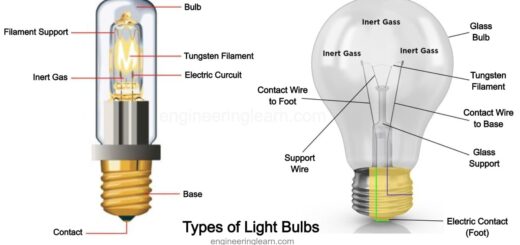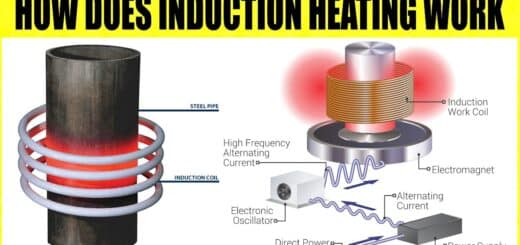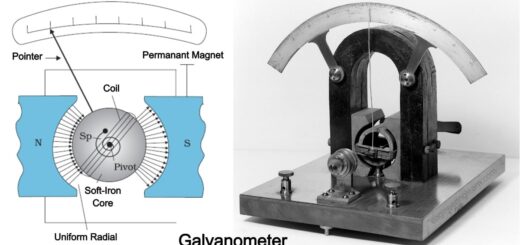What are Insulators? 10 Types of Insulators [Uses, Function, Properties, Advantages & Disadvantages]
![What are Insulators? 10 Types of Insulators [Uses, Function, Properties, Advantages & Disadvantages]](https://engineeringlearn.com/wp-content/uploads/2023/01/Insulators-1024x539.jpg)
What are Insulators?
What are Insulators? 10 Types of Insulators [Uses, Function, Properties, Advantages & Disadvantages]: – Insulators are materials that prevent electricity from flowing freely through them. This implies they may be used to stop the flow of electricity in a circuit and protect persons and things from electrical shock. Insulators are available in various materials, including glass, plastic, rubber, and air. Light bulbs, power lines, and electrical cables are all examples of insulators.
Insulators are widely employed in building electrical equipment and systems and serve a significant role in electrical safety: the insulator is any of many compounds that prevent or slow the passage of electrical or thermal current. Electrical insulators keep conductors in place while keeping them apart from one another and adjacent buildings. They act as a barrier between electrified elements of an electric circuit, limiting current flow to wires or other conducting routes as needed.
Electrical circuit insulation is a prerequisite for adequately functioning any electrical and electronic device. As electrical insulators, several materials are employed, with the choice based mainly on the unique needs of each application. Rubber or plastics are used to insulate the copper conductors used in the electrical wiring of households and industrial facilities from each other and the building. Overhead electricity wires are supported by porcelain insulators that do not deteriorate when exposed to the elements.
Mica is widely used to insulate large electric generators and motors at high voltages and temperatures. Solid insulation is combined with liquid or gaseous insulation in various situations. Solid insulation, for example, offers mechanical stiffness in high-voltage transformers, while oil or other liquid substances enhance insulation strength and help remove heat from the equipment. Insulating materials such as silicon nitride may be used in tiny architectures of integrated circuits with thicknesses as little as a micron.
Thermal Insulating
Thermal insulating materials include fiberglass, cork, and rock wool, a ball of mineral yarn created by blowing a jet of steam through molten siliceous rock, limestone, or slag. These and other poor thermal conductivity compounds slow the rate of heat movement. Because of their opacity to radiant heat and the interposition of multiple air voids, they break up the heat-flow route. Thermal conductivity is not always constant for any particular substance and may vary with temperature. In most metals and other crystalline materials, conductivity decreases with increasing temperature, whereas it rises in amorphous substances such as glass.
What is the Significance of Insulators?
The primary role of the insulator in the transmission line is to isolate the conductor from the transmission tower. They operate as a barrier between the active elements of an electrical circuit, limiting current flow to wires or other conducting routes as required.
When an electron travels in a wire, an electric current is created. Insulators are immobile because their electrons are securely bonded and do not move throughout the material. They retain the draft and separate the pole from the conductor to prevent current leakage to the ground.
Current will flow over the pole if it is not adequately insulated. If any animal or person comes into contact with the bar, they will be shocked, resulting in death.
How Do Insulators Function?
Energy will always be transferred from a higher temperature object to a lower temperature object. To put it another way, heat always flows from hot to cold. When insulating something, we attempt to prevent energy from being transferred from a more desirable to a colder object. Insulators keep energy from efficiently moving from one thing to another.
All objects are made up of tiny particles in a constant state of motion. Bonds bind the constituent parts of a thing together. Insulators are held in place by strong connections between their particles. Since particles in an insulator don’t move around quickly, the amount of energy transferred to other particles is minimal. This prevents particles from gaining power and increasing the temperature. Conductors have loose bonds that allow particles to move quickly and transfer energy from one particle to the next. Metals tend to be excellent conductors.
Types of Insulators
The primary kinds of insulators used in electricity transmission lines are as follows:
1. Disc Insulators: ( Types of Insulators )
As the name implies, the insulator has the form of a disc. Hence it is known as a disc insulator. These insulators are often found in high voltage transmission and distribution lines. Disc insulators are made to have the necessary electromechanical strength.
Furthermore, they offer a low-cost option for medium and low-polluted areas. Because of their high-efficiency properties, such as minimal corrosion and sturdy construction, these insulators are used in transmission lines and industrial and commercial applications.
Suspension and tension systems offer insulation and support for line conductors. It is also capable of holding high voltages under large loads.
Advantages of Disc Insulator
- It has an 11KV voltage rating. Thus it may be used to make a suspension string with a set of discs.
- The mechanical pressure is low due to the dangling line on the elastic suspension string.
- If the disc becomes damaged, it may be readily changed.
- It shields against noise, electricity, and heat and supports the above conductor.
Disadvantages of Disc Insulator
- Insulator strings are more costly than other varieties.
- They need a more significant height for sustaining the tower and preserving the conductor’s ground license.
- It generally needs a more extended cross arm.
- The tower must be strengthened to support the weight of the insulator.
2. Pin Insulators: ( Types of Insulators )
Pin insulators are often seen in power distribution lines. It is a device that protects a wire from physical support, such as a utility pole pin (wooden or metal dowel). It is a single-layer form constructed of a non-conductive material, most often porcelain or glass.
Depending on the voltage application, single or multiple pin insulators may be employed on physical support. The pin insulator can withstand up to 11kV and is made of a high mechanical strength material. These are placed either vertically or horizontally.
Advantages of Pin Insulators
- Pin insulators have higher mechanical strength and a longer creepage distance than other materials.
- They are ideal for high voltage power distribution lines.
- The critical benefit is that it may be installed vertically and horizontally.
Disadvantages of Pin Insulators
- The insulator must be arranged using a spindle.
- The voltage rating is restricted to 36kV and is only utilized in distribution lines.
- The insulator pin might harm the insulator thread.
3. Strain Insulators: ( Types of Insulators )
These insulators are intended to resist the stretch of a hung electrical wire or cable under mechanical stress. It functions similarly to a suspension insulator, supporting radio antennae and overhead power cables.
A strain insulator is placed between two lengths of wire to isolate them while preserving mechanical contact electrically. Alternatively, if a wire connects to a pole or tower, it is utilized to supply the pull of the wire while electrically insulating it. The voltage potential of these insulators is around 33kV.
Advantages of Strain Insulators
- These are simple to make from glass, porcelain, or fibreglass.
- The stay or guy wire will not fall to the ground if the insulator is destroyed.
- The strain insulator is isolated from the ground for low-voltage line applications.
4. Post Insulators: ( Types of Insulators )
Because it is suited for varying voltage levels, it is a high voltage insulator developed for use in substations. These are used to guarantee the safe and consistent distribution of energy produced in power plants.
Advantages of Post Insulators
- Post insulators offer high chemical and heat resistance.
- Post insulators for specified mechanical loads with strengths of hundreds of kilovolts are easily made.
- It is light in weight and prone to damage.
Disadvantages of Post Insulators
- Because the post insulator is lightweight, it places less strain on the supporting framework.
- The initial cost will be inexpensive, but the insulator’s lifespan will be short.
5. Shackle Insulators: ( Types of Insulators )
It features a tapered hole that evenly distributes the load force, lowering the risk of fracture when highly loaded. Following the growing usage of underground cables for distribution reasons, the use of insulators has lately declined.
Advantages of Shackle Insulators
- Shackle insulators are simple to build to suit power needs.
- Depending on the application, they may be positioned vertically or horizontally.
- These are the best ways to protect the safety of various electrical equipment.
Disadvantages of Shackle Insulators
- These insulators are very dependable for conductors.
- They are only applicable to low voltage distribution networks.
6. Suspension Insulators: ( Types of Insulators )
Insulators of this sort are often employed as conductors to safeguard overhead transmission cables. Suspension insulators are often used in towers and are constructed of porcelain. They feature many insulators linked in series to a form string.
It is hinged on the tower’s cross arm and has a power conductor at its lowest end. These are utilized when a greater voltage of about 33 kV is necessary. The cost of a pin insulator decreases as its size and weight increase. A suspension insulator is used to solve these challenges.
Advantages of Suspension Insulators
- Each device can run at a voltage of about 11kV.
- If the whole unit wears out, it may be quickly changed with a new one without replacing the string.
- Because the string may swing in any direction, it possesses excellent flexibility.
- The cost of insulation is cheap.
Disadvantages of Suspension Insulators
- Insulator string is more costly than pin-type and post-type insulators.
- A higher supporting structure is required to maintain the exact ground clearance as the current conductor.
- Because the conductors’ accessible swing amplitude is more significant in this case, the space between the conductors is more critical.
7. Polymer Insulators: ( Types of Insulators )
These electrical devices are often constructed of polymer materials and metal fittings. These insulators are also comprised of fibreglass rods encircled by polymer weather shelters. Weather blinds protect the insulator core from the elements.
Polymer insulators are less in weight than porcelain insulators and provide more power. In general, it is regarded as excellent heat and electrical insulator. Because of its peculiar properties, it is employed as an insulator.
Advantages of Polymer Insulators
- A polymer insulator has better tensile strength than a porcelain insulator.
- Performance is significantly superior to other varieties, particularly in polluted regions.
- Because its small weight places less strain on the supporting framework.
- Because of the insulator’s hydrophobic nature, less maintenance is necessary.
Disadvantages of Polymer Insulators
- When there is a space between the core and the weather shed, moisture might enter the body. This may cause insulator damage.
- Over-crimping in fittings may cause the core to break, resulting in mechanical failure of the insulator.
8. Stay Insulators: ( Types of Insulators )
It is a low voltage insulator that combines a stay wire or main grip to balance and secure dead-end poles. These insulators are rectangular and come in smaller sizes than other varieties.
These insulators may be used to connect the line conductor to the earth. Furthermore, they serve as protective mechanisms, guarding against short faults and voltage shifts. When the poles collapse to the ground or the stay wires are accidentally damaged owing to excessive mechanical stress, the value of these insulators becomes clear.
Advantages of Stay Insulators
- These are mainly used to balance the tension on guy wire arrangements.
- They also serve a vital function in sustaining the insulation between transmission poles.
Disadvantages of Stay Insulators
- They are exclusively used in low-voltage transmission lines.
9. Glass Insulators: ( Types of Insulators )
These insulators are typically composed of annealed or toughened glass and are used in power transmission lines. This insulator’s role is to insulate the electrical wires so that electricity does not leak into all of the poles and the ground.
Glass insulators were once employed in telegraph and telephone lines but were eventually supplanted with ceramic and porcelain kinds in the nineteenth century. Toughened glass varieties were produced to combat the weakness of glass, which became popular owing to their extended lifetime.
Advantages of Glass Insulators
- It has much greater dielectric strength than porcelain insulators.
- Because of the insulator’s transparency, contaminants and air bubbles may be readily recognized.
- It has a high resistivity and a low coefficient of thermal expansion.
Disadvantages of Glass Insulators
- Moisture rapidly condenses on its surface, restricting its usage to low voltage;
- For high voltages, the glass cannot be formed into an irregular shape because irregular cooling produces internal cooling and tension.
10. Long Rod Insulators: ( Types of Insulators )
Long rod insulators are often hinged on steel towers to insulate transmission lines. They also serve as protective devices by securely supplying electricity. Depending on their function and requirements, long rod insulators are often made up of many insulators.
On the exterior are porcelain rods with weather sheds and metal end fittings. The benefit of using this type of insulator is that it can be used in both tension and suspension applications.
Properties of Insulators
An insulator is a substance that restricts the movement of electrons. This means that an insulator can block electrical current. The five properties of an insulator are:
- They have a high resistivity. This means they do not allow an electric current to flow easily.
- They have a low conductivity.
- They are poor conductors of heat. They do not transfer heat well and tend to keep things cool.
- They are good insulators of sound. This means that they block noise and vibrations from passing through them.
- They are non-magnetic material.
Applications of Insulators
- These are used in circuits and electric boards to ensure safety techniques.
- These insulators protect the materials from high voltage surges and heat.
- Everyday items are made from plastics and rubbers.
Conclusion
As I have previously said, the insulator is a kind of equipment incapable of effectively conducting electricity. As a result, a general understanding of the insulators used in transmission lines can be gained, and it should be noted that each kind serves a particular purpose. When selecting an insulator, it is essential to consider several factors, including its dielectric element, operating temperature, economic factor, and recognized substance.













